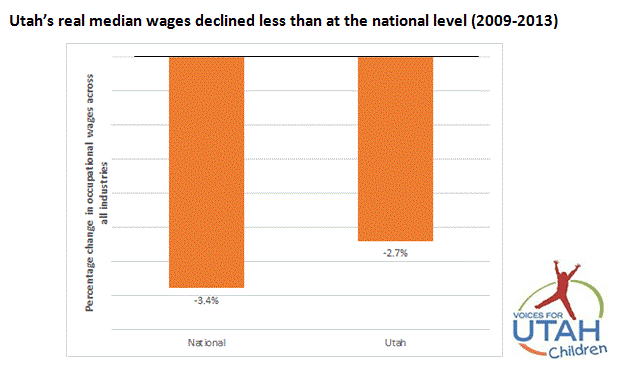Evaluating the performance of Utah’s economy from the perspective of Utah’s families and children is a matter of examining both the quantity and quality of jobs created since the state’s Great Recession employment trough in January 2010.
The principal findings of the report are as follows:
QUANTITY OF JOBS:
Controlling for differences in population growth rates, Utah’s rate of job creation in the recovery has lagged slightly behind that of the nation as a whole. Utah’s jobs-to-population ratio has fallen from 48.2% in 2007 to 45.2% in 2014, a steeper decline than that of the national economy. Utah’s ratio of new-jobs-to-new-population during 2011-2014 was 88% (148,958 new jobs compared to 168,556 new population during those four years), while for the nation as a whole, for the nation as a whole, the ratio was 92% (8,766,917 new jobs compared to 9,509,999 new population).
QUALITY OF JOBS:
 Utah wages have recovered from the Great Recession more quickly than the nation as a whole but remain below pre-recession levels. Averaged across all occupations, the real (inflation-adjusted) median wage in Utah was 2.7% lower in 2013 than it was in 2009, the peak year for wages. At the national level, things are even worse, with wages down by 3.4%.
Utah wages have recovered from the Great Recession more quickly than the nation as a whole but remain below pre-recession levels. Averaged across all occupations, the real (inflation-adjusted) median wage in Utah was 2.7% lower in 2013 than it was in 2009, the peak year for wages. At the national level, things are even worse, with wages down by 3.4%.
Wage inequality has grown in Utah. In both Utah and nationally, lower-wage occupations saw significantly larger declines in their real median wages than did mid-wage and higher-wage occupations, comparing 2009 to 2013. Occupations in the top three quintiles saw their median wages decline by about 1-1.5%. By contrast, occupations in the bottom two quintiles saw their median wages decline by 4-6%, and by more in Utah than nationally. This finding is consistent with the persistently elevated poverty rates that Utah has experienced since the recession ended.
New jobs in Utah pay much less than the ones they replaced. Jobs lost from 2008 Q1 to 2010 Q1 had an average wage of $53,277 while jobs gained from 2010 Q2 to 2014 Q2 had an average wage of $41,342, a decline of about 22%. This is largely due to the fact that higher-wage construction and manufacturing sectors saw significant job losses during the recession, while the fastest growing job sectors since then have included lower paying industries such as health care and retail trade.
Encouraging news on full-time/part-time: The share of the labor force working part time has dropped from a post-recession peak of 26% in 2012 to about 21% in 2014, which is below pre-recession levels. Involuntary part time levels, though, are still slightly higher than pre-recession levels at roughly 3% last year.
Productivity up, but wages down: Along with the nation as a whole, Utah is experiencing a troubling gap between productivity growth and wage growth. While the real median wage in Utah remains below its pre-recession peak, Utah saw 2.5% annual growth in private sector productivity over the time period 2009-2012.
OVERALL ECONOMIC OUTPUT
Recovery in overall economic output per capita in Utah remained behind the national recovery as of the end of 2013, the last year for which this data is available. Per capita real GDP peaked in Utah at $45,652 in 2007 and reached $45,165 in 2013, while for the nation as a whole, the comparable figures are $49,213 in 2007 and $49,115 in 2013. Thus, in 2013, the US was at 99.8% of the pre-recession level, while Utah was at 98.9%. Utah ranked 35th among the states by this measure of economic recovery.
View the complete report:





